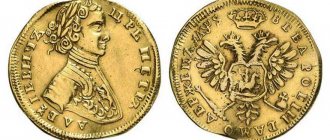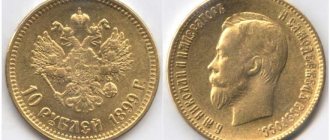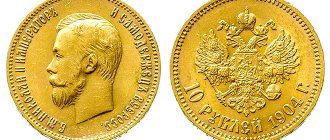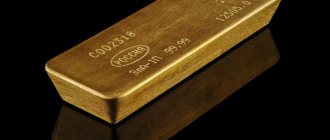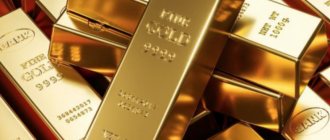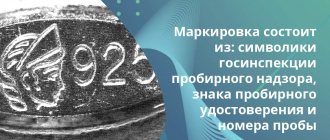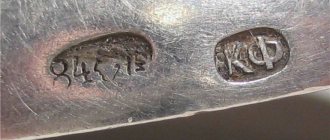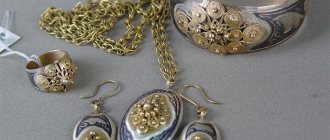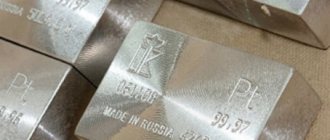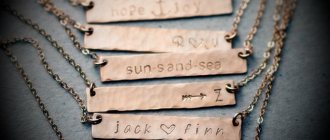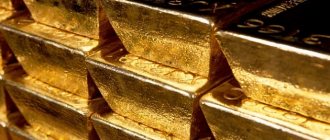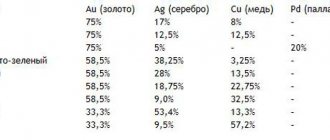Quick links with prices: 5 rubles | 7 rubles 50 kopecks | 10 rubles | 15 rubles | 10 stamps | 20 marks | Semi-Imperial | Imperial
If you want to sell or find out the cost of gold coins of Nicholas 2 , then our store will offer favorable conditions. We provide professional assessment (free) and purchase.
Nicholas 2 ascended the throne in 1894 at the age of 26 after the death of Alexander 3 from kidney disease. The “legacy” of the counter-reformist emperor was not easy. The first half of the 20th century saw action during the Russo-Japanese War, the first revolution, and later the First World War.
Sell 7 rub. 50 kopecks (1897)
7 1/2 rub.
How much can you sell 7.5 gold rubles for?
| Year Coins | Purchase price From | Purchase price Before |
| 1897 | 33 000 | 49 000 |
Price tag date 2021-10-15 Purchase price is indicated in rubles
The appearance of a product with an unusual denomination was associated with monetary and economic reforms. For 1 year - 1897 - minting was carried out under the leadership of Apollo Grashof. The circulation was just over 5,000,000 pieces. Experts who professionally evaluate coins indicate that these items resemble the five-ruble coins of Alexander 2.
Characteristics:
- denomination – 7 rubles. 50 kopecks,
- weight – 6.45 grams (5.81 – pure gold),
- circulation - just over 5,000,000,
- diameter - 21.3 mm.
The items are considered rare because they were not minted during Soviet times. Be careful: Nikolaev coins from rare minting years were often counterfeited. find out how much Nicholas 2 gold is worth after a professional appraisal. Our specialists will conduct an assessment and then offer terms of purchase.
Moscow center, 2 minutes from the metro
+7(800)333-14-77
Instant cash or non-cash payment
Soviet gold chervonets
A separate group are the “royal chervonets” of the Soviet coinage. Considering them a variety or classifying them as fakes is a rather problematic issue. There is no definite opinion on this matter.
The fact remains that for two years, from 1925 to 1926, the Leningrad Mint secretly minted gold coins in denominations of 10 rubles of the 1901 model.
The work was carried out in three shifts, and overtime was used if necessary.
The details of this secret special order have been preserved:
- December 1925 - 600,000 units;
- January 1926 - 411,000 units;
- February 1926 - 100,000 units;
- March 1926 – 900,000 units.
The result of the work was the release of 2,011,000 gold ten-ruble notes, analogues of the Tsar's chervonets.
Despite the fact that the minting was carried out very carefully and using equipment left over from pre-revolutionary times, the samples of the remake have characteristic differences. The likely reason is the use of stamps that have not been used before. The loss of the previous stamps did not allow achieving perfect similarity, and a number of significant differences make it easy to distinguish the original from the tsarist ten Soviet years of issue.
The differences relate to the obverse, which is different in size, wide outer edge and other details from the obverse of the old stamp. If numismatists call a pre-revolutionary portrait a “big head,” then the profile of the head of Emperor NICHOLAS II on Soviet samples is significantly smaller than its 1901 counterparts and is called a “small head.” The curve of the neck at the back of the head is more oval, for which among collectors the image received the apt name “light bulb” and the less common “Italian”.
Another difference between the “Soviet-Tsarist” chervonets is the details on the edge. They concern the brackets that contained the initials of the mintzmeister. On the edge of Soviet minted coins they stand much further from the letters. The letters themselves are also different. On pre-revolutionary banknotes the letter P is made in a perfect semicircle; on Soviet examples it looks triangular, like the letter G was minted by adding an additional stroke. There are also differences in the shape of the letter “Z” in the word forms “gold” and “zolotnik”. Soviet analogues are distinguished by more rounded ends, in contrast to the straightened ends of the letter “Z” on pre-revolutionary chervonets.
The massive circulation of coins from the bygone autocracy was explained by political and economic reasons, which the young Soviet government solved in such a unique way. In international payments, foreign countries refused to accept Soviet chervonets, making claims about the low quality of gold. But the royal ten-ruble notes were accepted very willingly. Another reason is that the cost of the imperial tens was significantly lower than the Soviet ones, so foreign partners accepted them more willingly.
Thus, with the help of the massive circulation of pre-revolutionary gold chervonets, the Soviet state was able to overcome the “golden blockade” of capitalist countries on the foreign economic market.
The cost of “remakes” is easy to calculate on your own: (exchange price of 1 gram of gold) x 0.9 (fineness coefficient 900) x 8.6 (weight of a gold chervonets) + 2-5% (numismatic markup if the buyer agrees to pay for Soviet coinage) = cost remake coins. See below for the real cost of the royal original.
Is it profitable to sell 10 rubles? (1898-1911)?
Sale 10 rub.
Price of gold ten rubles
| Year Coins | Purchase price From | Purchase price Before |
| 1898 | 30 000 | 39 000 |
| 1899 | 30 000 | 39 000 |
| 1900 | 31 000 | 40 000 |
| 1901 | 31 000 | 40 000 |
| 1902 | 31 000 | 40 000 |
| 1903 | 31 000 | 40 000 |
| 1904 | 35 000 | 55 000 |
| 1906 | rarity | |
| 1909 | 37 000 | 65 000 |
| 1910 | 75 000 | 155 000 |
| 1911 | 31 000 | 39 000 |
Price list date 2021-10-15 The purchase price is indicated in rubles.
The table shows approximately what the cost of ten rubles is. It will be possible to say more specifically after an assessment by our specialist (for this we invite you to a store in Moscow). The cost is due to the fairly large number of products. For example, the circulation in 1900 was 5,372,000. In total, more than 60,000,000 pieces were issued during minting. But 10 rubles. 1910 is considered expensive. If you are interested in how much the 1898 coin costs, come to our store in Moscow.
Coin characteristics:
- diameter – 22.5 mm,
- weight – 8.6 grams (7.74 of which are pure gold).
Compared to the “imperial”, the ten-ruble coins have “lost weight”. This is due to the difficult economic and political situation.
You get up to 80% of the real market price
+7(800)333-14-77
The office is under guard. Petrovka 38 nearby
How to spot a fake
10 rubles of 1901 made of gold due to its price and popularity attracts many counterfeiters. Cases of counterfeiting are quite common in this environment, which makes it urgent to correctly distinguish the original from all kinds of fakes.
The low price for a sold sample should be the first thing to worry about. The owner of a real coin will never give it away for nothing. Here the conclusion is clear: fake or criminal (stolen).
A high price is also not a guarantee of authenticity. They may deliberately inflate the price in order to reduce vigilance, and then make a concession during the bargaining process and sell the buyer a fake.
When purchasing a coin, you should be careful and check in every possible way. It should be noted that there are no universal ways to distinguish a fake from an original.
You can give only a few tips for independently analyzing the chervonets, but it is better to contact experienced numismatists:
- know the historical period of coin issue. For example, the image of an eagle must correspond to that year's national emblem;
- check "to the teeth". Determine the degree of metal hardness. Gold is a soft metal and can easily leave marks. Do not forget that a fake may be made of lead;
- magnetic properties. Gold has no magnetic properties;
- foreign metal. It is possible that the coin is gold plated. By slightly scratching the sample with a needle, it is easy to recognize a fake;
- nature of the surface. A perfectly smooth surface should raise suspicions. Having passed through decades, the chervonets cannot look perfect, especially from circulation;
- inspection of the herd. The initials of the mintzmeister must coincide with the officials who actually worked that year;
- specifications. The coin must correspond to the weight and diameter of that year of minting;
- detailed inspection of the stamp. Minting is a very labor-intensive process; counterfeits are usually cast. Such fakes will have small tubercles, drops of metal on the surface of the workpiece, easily distinguishable with a magnifying glass.
There are, of course, exemplary fakes that can mislead even experts, but such cases are very rare. If such a copy somehow ends up in the collection, do not be upset. A talented fake is also a rarity, which sometimes costs significant money.
Review 15 rub. last emperor?
Fig 1. Sell Semi-Imperial of Nicholas II
Sell 15 rub. in Moscow
| Year Coins | Purchase price From | Purchase price Before |
| 1897 | 42 000 | 65 000 |
Price tag date 2021-10-15 The purchase price is indicated in rubles.
It is another “atypical” coin that appeared in connection with the monetary reform. In 1897, more than 12 million pieces were minted, in 1899 - almost 2 times more (27 million). But in 1906, only 10 pieces were produced.
Characteristics:
- coinage – “AG” (Apollo Grashof),
- diameter – 24.6 mm,
- weight – 12.9 grams (11.61 – pure gold).
Depending on the obverse stamp, there are 2 varieties: under the neck trim OSS or SS. If you need to sell gold 15 rubles. , contact our store in Moscow. It is known that there were trial denominations of 15, 10 and 5 rubles. There are also so-called “Rus”, which never came into circulation.
Free call within Russia for consultation
+7(800)333-14-77
We buy expensive investment coins
The most expensive ten-ruble notes
People who do not understand numismatics often mistake other gold coins of the same denomination, minted in the same period, for the Nikolaev gold chervonets. They can actually cost hundreds of thousands of dollars apiece. But first things first:
- 10 Rusov. In the first years of the reign of the last Sovereign, Finance Minister Witte tried to radically change the name of the Russian currency. By analogy with the French francs, they chose the name “Rus”. However, this word is not on the coin; instead, there is the inscription “2/3 IMPERIAL” on the reverse. The edge is smooth. On the obverse is a portrait of Nicholas. Five sets were made per sample, but then this idea was abandoned. The cost of the kit averages 400 thousand dollars. But only two can come to market, having gone into personal collections. The other three are in museums. In the Russian Historical Museum, the Hermitage and the American Smithsonian Museum.
- 10 rubles 1906 The cost of a gold chervonets of 1906 is 100–200 thousand dollars. The reason is simple - only 10 of them were cast on the occasion of the anniversary of Nicholas's coronation. The richest collectors from all over the world compete at leading auctions for the right to own these coins, driving up prices to incredible heights.
- Imperials. Beginning numismatists often confuse them with ordinary Nikolaev chervonets, although these are completely different monetary units. You can distinguish it by the inscription “IMPERIAL” on the reverse, above the coat of arms. They were minted for 3 years in a row, from 1895 to 1897, with a total circulation of 375 pieces. Imperials were minted according to the “Alexander foot”; they weigh 12.9 grams. The cost of one copy ranges from 30 to 60 thousand rubles.
Cost 10 marks for Finland
Fig 1. Photo of 10 stamps
How much can you sell 10 stamps for in Moscow?
| Year Coins | Purchase price From | Purchase price Before |
| 1904 | 45 000 | 120 000 |
| 1905 | 115 000 | 225 000 |
| 1913 | 18 500 | 28 000 |
Price list date 2021-10-15 The purchase price is indicated in rubles.
10 stamps for Finland are of interest to numismatists. If you want to sell gold 10 marks, please contact the store in Moscow. Under Nicholas II, coins were minted only in 1904 and 1905. The copies are considered rare: in 1904, only a little more than 100 thousand appeared, and in 1905 - almost 43 thousand pieces. We also buy such items in our store. The 10 stamps for Finland have the following features:
- 900 gold standard,
- 3.23 grams of weight,
- 19.1 mm in diameter.
Profitable investment in royal coins
Like any antique, coins from past centuries only increase in value with the passage of time. According to the dynamics of the exchange rate, it is time to say with confidence that the sale of Nikolaev gold coins can be much more expensive than the cost for which they were purchased.
Buying, as well as selling, royal chervonets is not at all difficult. This is partly true, but you should be prepared for what you will need:
- a substantial amount for the initial purchase of coins;
- excellent knowledge of the history and numismatics of that time and the ability to navigate antiques well.
The authenticity of the royal 10-ruble coin must be confirmed by a special certificate. Among other things, don’t be afraid to ask the seller for the document. In addition, to avoid falling into the hands of scammers, some rules will help. First of all, you should buy royal money exclusively from a seller who has a good reputation. For this purpose, you can register on numismatic forums. There are few responsible sellers; online resources contain data regarding problematic transactions.
Sell 20 stamps for Finland
20 Finnish marks
At what price can you sell 20 stamps?
| Year Coins | Purchase price From | Purchase price Before |
| 1903 | 25 000 | 35 000 |
| 1904 | 25 000 | 35 000 |
| 1910 | ||
| 1911 | 25 000 | 35 000 |
| 1912 | rarity | |
| 1913 | 25 000 | 35 000 |
Price list date 2021-10-15 Purchase price is indicated in rubles.
20 stamps were minted in 1903 and 1904. Circulations are 112,000 and slightly more than 188,000, respectively. Expensive items from 1904 and 1905. Place of minting: Helsingfors Mint. 20 stamps are made of the same material, but their weight is almost 2 times greater (6.45 grams), and their diameter is 21.3 mm.
Tips for a novice collector
If you decide to invest your money in coins, it is worth remembering some of the nuances of this business:
- You can buy rare coins at specialized auctions, live or online,
- Many stores offer to buy Nikolaev chervonets in excellent condition. For example, the online store Slitok.Gold sells coins of that era with a guarantee of authenticity and good preservation.
- The authenticity of the Nikolaev chervonets must be verified by an experienced expert
- A change in the price of gold entails a change in the price of gold coins. Gold is a constant metal in terms of price, but there are still fluctuations, and it’s realistic to choose the best moment to buy coins or sell them.
- The value of coins is also influenced by the dollar exchange rate, which also needs to be monitored.
